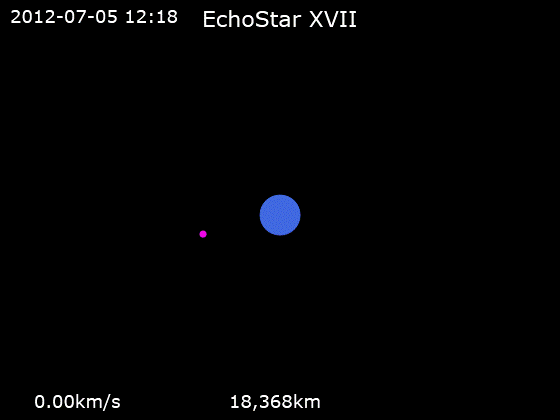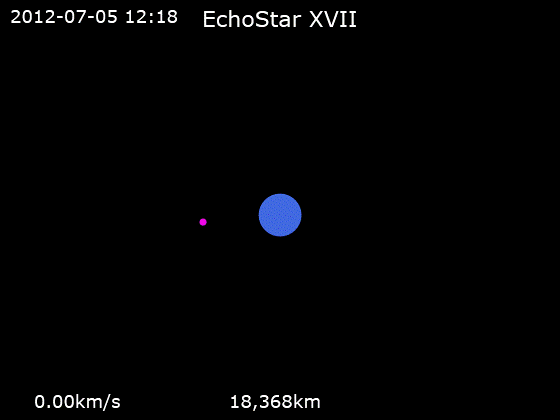EchoStar XVII on:
[Wikipedia]
[Google]
[Amazon]
EchoStar XVII or EchoStar 17, also known as Jupiter 1, is an American geostationary high throughput


communications satellite
A communications satellite is an artificial satellite that relays and amplifies radio telecommunication signals via a transponder; it creates a communication channel between a source transmitter and a receiver at different locations on Earth ...
which is operated by Hughes Network Systems, a subsidiary of EchoStar
EchoStar Corporation is an American company, a worldwide provider of satellite communication and Internet services through its Hughes Network Systems and EchoStar Satellite Services business segments. EchoStar is based out of unincorporated Ar ...
. It is positioned in geostationary orbit
A geostationary orbit, also referred to as a geosynchronous equatorial orbit''Geostationary orbit'' and ''Geosynchronous (equatorial) orbit'' are used somewhat interchangeably in sources. (GEO), is a circular geosynchronous orbit in altitu ...
at a longitude
Longitude (, ) is a geographic coordinate that specifies the east– west position of a point on the surface of the Earth, or another celestial body. It is an angular measurement, usually expressed in degrees and denoted by the Greek let ...
of 107.1° West, from where it is used for satellite internet access
Satellite Internet access is Internet access provided through communication satellites. Modern consumer grade satellite Internet service is typically provided to individual users through geostationary satellites that can offer relatively high d ...
over HughesNet.
EchoStar XVII was built by Space Systems/Loral
SSL, formerly Space Systems/Loral, LLC (SS/L), of Palo Alto, California, is a wholly owned manufacturing subsidiary of Maxar Technologies.
SSL designs and builds satellites and space systems for a wide variety of government and commercial cust ...
, and is based on the LS-1300
The SSL 1300, previously the LS-1300 and the FS-1300, is a satellite bus produced by Maxar Technologies. Total broadcast power ranges from 5 to 25 kW, and the platform can accommodate from 12 to 150 transponders. The SSL 1300 is a modular platf ...
satellite bus
A satellite bus (or spacecraft bus) is the main body and structural component of a satellite or spacecraft, in which the payload and all scientific instruments are held.
Bus-derived satellites are opposed to specially produced satellites. Bus- ...
. It measures by by , with solar arrays which were deployed after launch, and generates a minimum of 16.1 kilowatts of power. The spacecraft had a mass at liftoff of , and is expected to operate for fifteen years. It carries sixty (NATO K band) transponder
In telecommunications, a transponder is a device that, upon receiving a signal, emits a different signal in response. The term is a blend of ''transmitter'' and ''responder''.
In air navigation or radio frequency identification, a flight trans ...
s which is used to cover North America
North America is a continent in the Northern Hemisphere and almost entirely within the Western Hemisphere. It is bordered to the north by the Arctic Ocean, to the east by the Atlantic Ocean, to the southeast by South America and th ...
.
EchoStar XVII was launched by Arianespace
Arianespace SA is a French company founded in 1980 as the world's first commercial launch service provider. It undertakes the operation and marketing of the Ariane programme. The company offers a number of different launch vehicles: the heavy ...
, using an Ariane 5ECA carrier rocket flying from ELA-3 at Kourou
Kourou () is a commune in French Guiana, an overseas region and department of France in South America. Kourou is famous for being the location of the Guiana Space Centre, the main spaceport of France and the European Space Agency (ESA). It i ...
. The spacecraft was launched at 21:36 UTC on 5 July 2012. The MSG-3
Reliability-centered maintenance (RCM) is a concept of maintenance planning to ensure that systems continue to do what their user require in their present operating context. Successful implementation of RCM will lead to increase in cost effecti ...
weather satellite was launched aboard the same rocket, mounted below EchoStar XVII, which was atop a Sylda 5 adaptor. The launch successfully placed both satellites into a geosynchronous transfer orbit
A geosynchronous transfer orbit or geostationary transfer orbit (GTO) is a type of geocentric orbit. Satellites that are destined for geosynchronous (GSO) or geostationary orbit (GEO) are (almost) always put into a GTO as an intermediate step f ...
. EchoStar XVII used its own propulsion system to manoeuvre into a geostationary orbit.
Path to geostationary orbit


See also
* ViaSat-1 – Similar high throughput satellite that was the source of a lawsuit to the manufacturer of both * 2012 in spaceflightReferences
{{EchoStar satellites Spacecraft launched in 2012 High throughput satellites Communications satellites in geostationary orbit Ariane commercial payloads E17